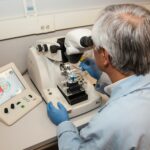Are you ready to uncover the hidden world that lies beyond what the naked eye can see? In the realm of scientific exploration, compound microscopes reign as the indispensable tool for delving into the microscopic wonders that shape our understanding of the natural world. But what truly lies within the capabilities and limitations of these powerful instruments? Join me as we embark on a journey through the realm of compound microscopes, where we will unravel the intricacies of resolution, depth of field, and sample preparation. As an experienced scientific researcher with a background in microscopy, I am prepared to guide you through this fascinating exploration, shedding light on the practical applications and scientific implications that arise from these remarkable scientific marvels. Get ready to dive deep into the captivating world of compound microscopes!

Capabilities and Limitations of Compound Microscopes
As an experienced scientific researcher with a background in microscopy, I have had the privileged opportunity to delve into the fascinating world of compound microscopes. These powerful tools have revolutionized our ability to explore the microscopic world and unravel the intricacies of various scientific fields. In this article, I will provide you with valuable insights into the capabilities and limitations of compound microscopes.
Exploring the Capabilities
Compound microscopes are a significant advancement over simple microscopes, as they overcome the limitations of resolution and magnifying power. They achieve this by utilizing two lens arrays: the objective lens and the eyepiece. The arrangement of these lenses enables the microscope to relay the image with high resolution and magnification capabilities, allowing us to discern intricate details that would otherwise be invisible to the naked eye.
The body tube of a compound microscope plays a vital role in ensuring continuous alignment of the optics. By separating the objective and the eyepiece, it maintains the integrity of the image throughout the observation process. The ergonomic design of compound microscopes provides stability and ease of use, making them a reliable tool in various laboratory settings.
One of the key advantages of compound microscopes lies in their ability to gather light from the object being observed. The numerical aperture of a microscope is a measure of its capability in this regard. A higher numerical aperture allows for increased light collection and, consequently, improved image quality. This feature is particularly important when studying samples with low light emission, such as fluorescently labeled cells or thin sections of biological tissues.
Unveiling the Limitations
While compound microscopes offer numerous benefits, it is crucial to acknowledge their limitations. One of the primary limitations is the finite depth of field. When observing three-dimensional specimens, only a small portion of the sample can be in sharp focus at any given time. This can present challenges when trying to capture the overall structure of complex objects, such as intricate cell networks or intricate surfaces.
Another significant limitation is the resolution capacity of compound microscopes. Although they provide enhanced magnification capabilities, there comes a point where further magnification does not lead to increased image clarity. This limitation arises from the physics of light and the inherent properties of the lenses used in microscopy.
Sample preparation is another aspect that warrants attention when using compound microscopes. In some cases, it can be time-consuming and intricate, requiring specific staining or fixation protocols to enhance visibility or preserve delicate structures. Additionally, certain samples may require specialized techniques, such as thin sectioning or staining with specific dyes, to achieve optimal visualization.
Emphasizing the Practical Implications
Understanding the capabilities and limitations of compound microscopes is crucial for any researcher or scientist working in the field of microscopy. By comprehending these factors, we can maximize the potential of this essential scientific tool while being mindful of its inherent limitations.
The practical implications of compound microscopes span across various scientific disciplines, including biology, medicine, and materials science. These instruments have greatly contributed to our understanding of the microscopic world, enabling breakthrough discoveries in fields such as cell biology, pathology, and materials characterization.
In conclusion, compound microscopes are remarkable scientific tools with immense capabilities in visualizing the minuscule world. Their ability to provide high resolution and magnification capabilities has revolutionized scientific research and contributed to our understanding of the world around us. However, it is essential to acknowledge their limitations, such as finite depth of field, resolution constraints, and sample preparation requirements. By being aware of these capabilities and limitations, scientists can make informed decisions and extract valuable insights from their microscopic observations.
“Compound microscopes offer us a glimpse into the hidden world, illuminating the tiniest details that shape our understanding of science. While they have their limitations, the capabilities of these instruments continue to push the boundaries of human knowledge.”
A compound microscope is a powerful tool used by scientists and researchers to explore the intricate details of the microscopic world. With its high magnification capabilities and advanced optical system, a compound microscope allows for the observation and analysis of tiny specimens with great precision. Whether you’re a student studying biology or a professional scientist in need of a reliable instrument, the compound microscope is an indispensable tool that can revolutionize your understanding of the natural world. Dive into the fascinating realm of microscopy by clicking on this active internal link to learn more about the incredible possibilities offered by a compound microscope: Compound Microscope.
FAQ
Question 1
What are the main advantages of compound microscopes over simple microscopes?
Answer 1
Compound microscopes offer higher resolution and magnifying power compared to simple microscopes. They achieve this by using two lens arrays, the objective lens and the eyepiece, to relay the image and provide enhanced capabilities.
Question 2
How does the arrangement of lenses in a compound microscope contribute to its functionality?
Answer 2
The arrangement of lenses in a compound microscope allows for magnification of objects and the ability to discern detail. The objective lens captures the image and relays it to the eyepiece, providing a clear and magnified view of the specimen.
Question 3
What is the role of the body tube in a compound microscope?
Answer 3
The body tube of a compound microscope separates the objective and the eyepiece and ensures continuous alignment of the optics. It helps maintain the focus and clarity of the image by keeping the lenses properly positioned.
Question 4
What is numerical aperture and how does it impact the performance of a compound microscope?
Answer 4
The numerical aperture of a microscope is a measure of its capability to gather light from the object. A higher numerical aperture allows for better resolution and enhanced detail in the image. It plays a crucial role in determining the clarity and quality of the microscopic view.
Question 5
How is the total magnification of a compound light microscope determined?
Answer 5
The total magnification of a compound light microscope is determined by multiplying the power of the objective lens by the power of the eyepiece. This combination of magnification from both lenses allows for detailed examination of microscopic specimens.
















